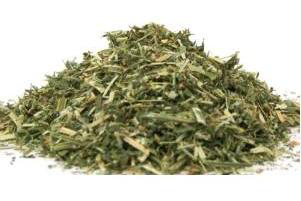The potential of alfalfa leaf meal as a fish feed

On a global scale aquaculture is the fastest growing animal protein sector. However, many fish require fish proteins in their diets and the availability is limited. Nutritionists on a continuous basis are searching for alternatives to replace the animal protein with plant protein. Indian researchers investigated the possibilities of alfalfa meal in fish diets.
By: By S.A. Vhanalakar and D.V. Muley, Maharashtra, India
Fish meal represents an ideal nutritional source of dietary protein and lipid for fish. It is the most important protein source for the aquaculture industry because of its high biological value, but this is a limited food resource and there is serious concern about the long-term availability of this feed stuff for use in fish diets. The aquaculture industry depends worldwide on the availability of low cost, high quality feed. Over several decades, fish nutritionists have evaluated alternative sources of plant origin protein in fish diets as partial or total fishmeal replacement.
Good nutrition in animal production systems is essential to economically produce a healthy, high quality product. In fish farming, nutrition is critical because feed represents 40-50% of the production costs. Fish nutrition has advanced dramatically in recent years with the development of new, balanced commercial diets that promote optimal fish growth and health. The development of new species-specific diet formulations supports the fish farming industry as it expands to satisfy increasing demand for affordable, safe, and high-quality products.
For commercial culture of fish, the formulation of a low-cost balanced diet using locally available agro-industry byproducts is needed. Recently fishmeal has become the most expensive protein ingredient in aquaculture feeds. Many developing countries have realised that, in the long run, they will be unable to afford fishmeal as a major protein source in aquafeeds. Currently one of the challenges that fish nutritionist face is to partially or totally replace fishmeal with less expensive, non-traditional animal or plant protein sources. Many studies have shown considerable success in partially replacing fishmeal with soybean meal and other soybean products in the diet of various fish species. Research interest has been focused on different leaf meals as protein sources in fish feed. Fish nutritionists have evaluated alternative sources of plant origin protein in fish diets as partial or total fishmeal replacement.
Alfalfa meal
Alfalfa (Medicago sativa) is a flowering plant in the pea family (Fabaceae), cultivated as an important forage crop. In the United Kingdom, Australia and New Zealand it is known as Lucerne and as Lucerne grass in south Asia. Alfalfa is widely grown throughout the world as forage for cattle due to its high protein content. In early Chinese medicines, physicians used young alfalfa leaves to treat disorders related to the digestive tract and the kidneys. Ayurvedic physicians used the leaves for treating poor digestion. In an experiment, fresh leaves of alfalfa plant were used in the formulation of fish feed. Dried leaves of alfafa in powder form were used for preparing fish feed. It was tested in the diet of a freshwater fish, Cirrhinus mrigala (Mrigal carp) under laboratory conditions. The feeding experiment was carried out for three months. The various experimental diets contained different combinations of dry alfalfa leaf meal, mixed with groundnut oil cake, rice bran, guar gum binder and a mineral vitamin
mixture (Table 1). Ingredients were mixed thoroughly in a kitchen mixer till a homogenous mass was obtained. With the help of a mincer, pellets were prepared, which were immediately sun dried. After drying, the pellets were hand broken up into convenient pellet sizes and frozen until before feeding. In this experiment the alfalfa was incorporated at various percentage levels to check the effectiveness as a fish feed ingredient. Medcago sativa solely does not have the capacity to replace the traditional fish meal. Therefore it is used as a supplementary fish feed ingredient along with the traditional ingredients; but the incorporation level of traditional ingredients like groundnut oilcake, rice bran etc. was kept at a lower inclusion level.
Growth performance on alfalfa diet
The growth performance of Mrigal carp on the alfalfa diet is presented in Figure 1. The present study confirmed that Mrigal carp is able to utilise the plant based formulated diet. An inclusion level of up to 30% in the practical diet for Mrigal carp fingerlings had no adverse effects on growth, feed utilisation efficiencies or body composition of the fish. From the present work it is concluded that, Medicago sativa may be a promising source of plant protein; used for partial replacement of fishmeal in the formulated fish feed. It will definitely help small scale fish farmers to cut costs on traditional fish feed.
S.A. Vhanalakar works at the Department of Zoology, Karmaveer Hire Arts, Science, Commerce and Education College. D.V. Muley works at the Department of Zoology of the Shivaji University, both located in Maharashtra, India.
Join 26,000+ subscribers
Subscribe to our newsletter to stay updated about all the need-to-know content in the feed sector, three times a week. Beheer
Beheer









 WP Admin
WP Admin  Bewerk bericht
Bewerk bericht